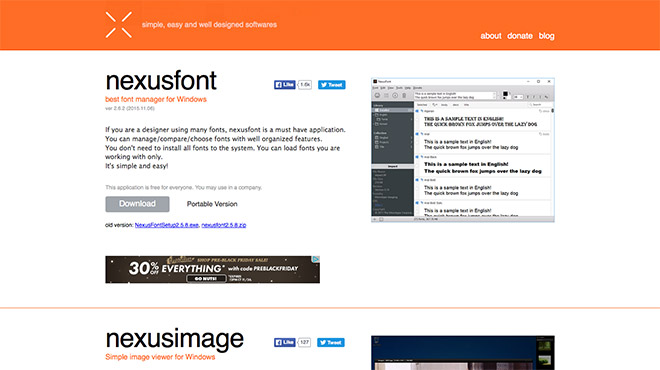I’m going to preface this article by saying that I was a loyal user of Extensis Suitcase Fusion font management software since 2008. For the longest time, I was spoiled by its smart filters, customizable collections, and auto-activation capabilities. However, in the last couple of years I got tired of needing to keep this bloated beast on my system. The upgrades were expensive and each time they updated their software, the changes seemed to make my system run harder. Worst of all, it was starting to offer no real benefit to my workflow.
After a recent update to MacOS Sierra, my version of Suitcase Fusion decided that it wanted to die. Auto-activation no longer worked with Adobe Creative Cloud 2017. Even though I could get it to eventually load and manage my fonts, it required that I ‘OK’ my way through a long series of error messages, installer warnings, and finally login with my administrator password—which is just kind of bullshit.
Time to hunt for a new font management system!
FontExplorer is perhaps the most functional and popular font management software for Mac OS. It supports all the formats you can imagine including web fonts. You can split fonts into sets and subcategories. And use filters and search for quick access to them. FontAgent Pro 4 by Inside Software is another choice for full-featured font management, available for $99. This application has a very similar feature set to FontExplorer X Pro, including plug-ins for the current versions of Adobe Creative Suite and QuarkXpress for automatic activation of font sets.
The first thing I did when looking for a new system was decide what was really important. After all, you can’t find something if you don’t know what you’re looking for! So I sat down and thought about how I intend to use my fonts, what I liked (or didn’t like) about management systems I have already used, and how I could make improvements to my current workflow.

First of all, I had a few things that I knew I didn’t need.
I work in a small team. Because it’s just me and my husband, I had no need for font server technology or bulk pricing on software licenses. I speak English natively and work primarily on English projects. This means that I don’t need my software to be bloated with multiple language translations. Both of us work in Mac (and Linux) operating systems, so support for Windows is not wanted or required. Windows is a terrible operating system.
When it comes to what I did need, my requirements were pretty simple.
I want to be able to get quick and customizable previews of my library of fonts. It would be great to have the ability to quickly filter and search for fonts. Saving these selections into collections labeled by type classification, foundry, feeling, or by client is imperative. Also, auto-activation with Adobe Creative Cloud has to be available because I am lazy—I mean, because I am efficient.
Finally, I am really sensitive about my file organization system. I want my file system to either remain untouched or to be organized nicely in a way that I can find what I need later on. This is where I have always had problems in the past. Most font management systems drop copies of installed fonts into a single subdirectory in the user’s /Library/ folder—which in my opinion is the ugliest method of storage imaginable. It seriously gives me the shivers.
Why not pick the free option?

Font Book, which ships free with Macs, bothers the crap out of me. Yes, it’s fast and yes, it’s free. But it doesn’t offer the features I find to be most important in my workflow. The file system is mushed together into a large ugly directory that you can (optionally) manually maintain—but that’s a timesink for me. And while they do have a decent collection system, their preview system is on a font-by-font basis. Sometimes I need that palette of font previews right in my face to get my creative juices flowing. Sifting through thousand of fonts one by one is a no go.
What about the most ‘professional’ options?

Some would argue that you mean Extensis Suitcase Fusion. Others would say you mean Monotype’s FontExplorer X. Both are essentially the same heavy software that is so feature-rich that the software gets slow and hard to use. Both of these options let you preview and auto-activate your fonts, but they dump installed font files into their own proprietary libraries. They offer smart collections, filter, categories, font meta information… all the bells and whistles a professional designer thinks they need.
But I just don’t need all of that. I want something lightweight, fast, and minimal. Something that won’t get in my way when I’m trying to do something quickly, but is powerful enough to give me the info I’m looking for when I want it.
Reviews of Font Management Software for Mac
FontAgent by Insider Software
$99 for a Single-User License (30-day Trial)

FontAgent’s interface is a dead ringer for a Suitcase Fusion or a FontExplorer X clone. If you’re already comfortable with this layout and like it, chances are you will like FontAgent as well. On the surface this software seems to deliver everything I was looking for. They have auto-activation for Creative Cloud, extensive filtering and smart collections, as well as custom collections. Their file system, however, is handled just like all of the rest. They store copies of the font files in one large directory inside of a proprietary directory in the user library. Yuck.
This might have been forgivable if the software itself was not also slow and sluggish. As I was scrolling through just a portion of the system fonts, the preview chugged along and very slowly caught up with me. I was not impressed by this. Even though they have a 30-day free trial available—which is great—I didn’t need more than 30 minutes to realize that my princess was in another castle.

RightFont by Markly Team
$50 For a Single-User License
Best Font Management Software For Mac 2016 Free
Upfront, there is a lot to like about RightFont. It looks great. The interface is clean and simple with a single window that lists all of your fonts. There is an option to quickly get to the app right from your menu bar. The filter and search options are diverse as are the preview options. Auto-activation works flawlessly and you can even scroll through active fonts to watch the changes automatically applied inside your Adobe software. It comes with a plethora of icon sets pre-installed as well as offers immediate in-app connectivity to Google Fonts and Adobe Typekit
It’s super easy to import new fonts. When you do, it copies each font into it’s own alphabetized directory. (Yay!) However, it leaves dead directories whenever you move a font to the trash. If you don’t want to use their file system, you can create “Live Lists” which allows you to access and activate fonts stored elsewhere on your system—like in a Dropbox folder.
There are two huge downsides to their software. The first is that there is no way to view the entire character set for a font. What this means is if you want to preview individual glyphs, you’re basically S.O.L. The second downside is that you’re asked to take a $50 leap of faith because there is no free trial period. It’s not a deal breaker—there is a 15-day money back guarantee—but it is cause for a major pause.
Typeface by Criminalbird
$10 For a Family-Share License via the App Store
I want to love this font management app. I really do. First of all, it’s extremely fast, lightweight, and beautifully designed. You can quickly view all of the installed fonts on your system with a nice customizable palette of previews. The filtering system is fast, intuitive, and has a solid range of selections. You can choose to invert the colors and a recent update even gave users the ability to export a PDF of your font selections to present to clients.
My favorite part though is their addition of font comparison, outlines, and a markup options. These allow you see the the design differences between two fonts and get a better idea of the structure of each font. If you’re into studying typography, this is a super cool and very unique feature that makes it worth getting the app all by itself.
However, there is no integration with Google Fonts or Adobe Typekit. There is also no auto-activation in Creative Cloud. You can choose to preview fonts in any directory, but Typeface does not handle font installation and it really sucks at activation and deactivation. This part of the their software piggybacks off of Font Book, Mac’s free font management software. The big-picture means that all—yes all—of your fonts need to be installed on your system. Additionally, when you deactivate one of these installed fonts, it disappears into oblivion and can’t be reactivated later. The only way to get it back is to reinstall it in Font Book. Bummer, right?
On the upside, the developers seem to really give a damn about making a good product and I like that. You can see that they are listening to their customers by comparing the app reviews with the changes made in subsequent updates. That kind of support is priceless and it makes me think that even if I don’t love it now, one day I might.
Which Font Management Software Did I Choose?
All in all, I spent a lot of time reading user reviews, playing with each application, and testing all of my key workflow processes in various configurations. It was not an easy decision to make, but what I decided was:
Use RightFont as my primary font management system alongsideTypeface which will act as my font analysis software.
I really liked how RightFont handled activating and deactivating fonts, their organized file system, their star and collection system, and the fact that it played well with other apps and online font services. Other than those dang zombie directories it leaves, it’s seemingly perfect for all my needs. However, I really hate how it handles analysis. Typeface, hands down, works the best on that font. It quickly give me all the information I need and lets me compare and contrasts two fonts without batting an eyelash.
Best Font Management Software For Mac 2016 Crack
Once you activate a font with RightFont, you can then access it with Typeface! This was a pleasant surprise and the deciding factor on my new hybrid font management system.
